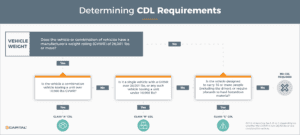
CDL for Dummies: A Beginner's Guide to Commercial Drivers Licenses (CDLs)
Content
- Is CDL for Dummies for Dummies?
- What is a Commercial Driver’s License (CDL)?
- The Types of Commercial Drivers Licenses (CDLs)
- The CDL for Dummies 13 Steps to Getting Your Commercial Driver’s License
- How Much Does a Commercial Driver’s License (CDL) Cost?
- Driving Schools & Commercial Learner’s Permits
- How Difficult Is It To Get a Commercial Driver’s License?
- Where Can You Get a Commercial Driver’s License?
- How quickly can you get a CDL?
- Conclusion
- Key Takeaways
Truck driving can offer competitive pay and opportunities for those who enjoy independence, traveling, and have a penchant for the profession. Opportunities to join the industry are abundant as the industry undergoes a truck driver shortage. In response, trucking companies are increasing their efforts to appeal to a broader range of candidates, including younger individuals, retirees from other professions, military veterans, and foreign nationals.
Learning to become a truck driver and getting your CDL (commercial driver’s license) is the first step to becoming part of this $940+ billion industry. However, there are three different classes of CDL and numerous endorsements that permit you to transport certain types of cargo. CDL for Dummies is a guide meant to simplify essential concepts, make them easier to understand, and help you choose the professional driving career you want to pursue.
Before you investigate driving schools and job opportunities, understand the type of truck you want to operate, the cargo you can haul, and the job conditions you want. The type of CDL you have will determine what you are licensed to drive, haul, and under what conditions.
CDL for Dummies is a guide for beginners and the starting point for choosing the professional driving career you want to pursue.
Is CDL for Dummies for Dummies?
Definitely not! CLD for Dummies is a condensed guide to allow those interested in pursuing a commercial driving career the opportunity to grasp the time, effort, and costs involved in getting started. The term “CDL for Dummies” is meant, not as an offending term, but as an expression of breaking down multiple concepts into simple, easy-to-understand explanations.
The CDL for Dummies guide begins with a breakdown of what a CDL is.
What is a Commercial Driver’s License (CDL)?
CDLs are required for heavy, oversized vehicles that move bulk commodities and large equipment, as well as those that carry multiple passengers, such as school buses.
Driver’s with a CDL are qualified to operate dry van, refrigerated, or flatbed rig and haul a range of well paying cargo. In addition to a CDL, drivers can add endorsements that allow them to transport hazardous materials such as chemicals, explosives, flammable liquids, and radioactive materials. Drivers with other endorsements can operate specialized equipment, such as double and triple combination tractor-trailers, and transport bulk liquids in tanker trailers.
Jump here to see the ultimate list of available jobs for truck drivers and the required endorsements.
The Types of Commercial Drivers Licenses (CDLs)
U.S. Federal regulations require a CDL if you are operating a vehicle weighing 26,001 pounds or more, transporting 16 passengers or more, or transporting hazardous materials across state lines. There are three CDL classifications to ensure drivers are appropriately trained and qualified to operate vehicles of varying sizes, weights, and purposes.
Confused about the different CDL classifications? Our CDL for Dummies breakdown simplifies the distinctions between Class A, B, and C licenses.
Following are the three different classifications of CDLs:
Class A: The most popular CDL is Class A. This classification permits drivers to operate a motor vehicle with a gross combination weight rating (GCWR) of 26,001 pounds or more and towing equipment with a gross vehicle weight rating (GVWR) of 10,000 pounds or more. This license class permits freight hauling using dry van, flatbed, and reefer trailers with more than one axle. With this truck driving license, you can cross state lines and operate along the interstate. With the Class A CDL, you’re permitted to operate any vehicle covered under either a Class B or Class C and to drive a Class 8 truck. This class is best for people looking for an over-the-road (OTR) career with high earning potential and job security.
Class B: This classification permits drivers to operate a single vehicle with a gross combination weight rating (GCWR) of 26,001 pounds or more and trucks with a detached towed cargo vehicle weighing less than 10,000 pounds. This class is best for people looking for local trucking jobs within the service or utility industries.
Class C: This classification is required for drivers operating commercial vehicles weighing less than 26,001 pounds or a truck towing another vehicle that weighs fewer than 10,000 pounds. Additionally, if the operator has the correct endorsements, they can operate vehicles designed to transport at least 16 passengers (including the driver) or to carry hazardous material. This class suits those wanting to operate school buses, airport limousines, small hazmat vehicles, etc.
The CDL for Dummies 13 Steps to Getting Your Commercial Driver’s License
To obtain a CDL, you’ll need to navigate through a series of steps. Here’s the CDL for Dummies guide to help you through the process:
- Be at least 21 years of age (at least 18 years of age to drive intrastate).
- To obtain a Class A or Class B CDL, you must complete FMCSA-approved driver training.
- Submit your CDL Application and pay the appropriate fees.
- Verify your identity and Social Security number (be sure to check your state’s requirements).
- Provide proof of state and U.S. residency.
- Submit a completed Medical Examination Report Form and Medical Examiner’s Certificate Form.
- To obtain a Class A or Class B CDL, you must take theory training from an approved theory training provider listed in the FMCSA Training Provider Registry (TPR).
- Pass all written tests. Your provider will send your training records to the TPR once you have successfully completed this training. With this training your state DMV will allow you to take the official written knowledge test for a Commercial Learner’s Permit (CLP).
- Pass a vision test.
- Receive CLP.
- Once your CLP is in hand, wait 14 days (minimum) before scheduling your CDL road skills test.
- Pass all three sections of the Skills Test: the Vehicle Inspection Test, the Basic Controls Test, and the Road Test.
Note: You must take behind-the-wheel (BTW) training from an approved BTW training provider listed on the TPR before your state DMV will allow you to take the official skills test for a CDL. - When you have passed, pay the CDL fees (optionally, submit a 10-year record check if you have had a license in any other state or jurisdiction than the one where you are applying).
Please note that there may be variations to the above listed CDL for Dummies steps, depending on your state.
How Much Does a Commercial Driver’s License (CDL) Cost?
The cost of acquiring a CDL depends on your state or province of residence. To determine the exact cost of a CDL for your state, visit your state’s Department of Motor Vehicles or the Department of Revenue website. State variance aside, here is a breakdown of the average prices:
Written/Knowledge Tests
- Written tests can cost up to $25 each
Skills/Road Tests
- The skills testing, which includes a road test, a pre-trip inspection test, and a basic vehicle control test, can cost up to $250
- The CDL itself can cost up to $200
Fees & Endorsements
- Application fees can range from $0 – $43
- Endorsements cost between $5 to $10 (not including testing fees)
Permits, Training & Tuition
- Permits (i.e., Commercial Learner’s Permit [CLP]) can cost up to $50
- If you decide you’d like to take a private school course, tuition can range from $1,000 – $5,000 and may include additional costs for materials, drug screenings, permit tests, and a physical.
In summary, the CDL for Dummies estimated cost for getting your CDL can be up to $575 USD from start to finish without private school tuition.
Driving Schools & Commercial Learner’s Permits
Not every state or province requires driving school training, but this CDL for Dummies guide highly encourages it. Professional training provides hands-on experience and allows you to network early in your career.
You can attend two types of truck driving schools: paid CDL training programs (often provided by larger fleets) or private training schools.
Paid CDL Training Schools benefit new drivers because there is almost zero cost upfront, and you will be able to start working as soon as you complete the program and have your CDL. Private schools often offer college credits or certificates upon completing their program.
If you’d prefer not to go to a training school, you can obtain a Commercial Learner’s Permit (CLP) and practice operating commercial vehicles with a qualified CLD driver. You must pass three tests covering general knowledge, combination vehicles, and air brakes to get your CLP.
How Difficult Is It To Get a Commercial Driver’s License?
CDL for Dummies is a condensed guide offering most of the information you need to plan your path forward for obtaining a CDL. It is not an overly complex process. Most truckers find the written exams easy to pass. Each state provides a Commercial Driver’s License training manual (as does the FMCSA), but plenty of free CDL practice tests are available online (example).
Where Can You Get a Commercial Driver’s License?
CDL for Dummies recommends attending a professional training school for those seeking comprehensive education, qualified instruction, exam preparation, and job placement assistance. There are several options:
- Private CDL schools
- Community colleges
- Company-sponsored training programs
- Military Skills Test Waiver Programs
How quickly can you get a CDL?
With comprehensive training, it could take four to six weeks to get your Commercial Driver’s License. Without training, it could take as little as two-to-three weeks, including the 14-day wait period between receiving your CPL and taking your road skills test.
Conclusion
For new drivers committed to obtaining their CDL, the process is straightforward, can be completed in weeks, and is relatively inexpensive when compared to earning potential. Each type of CDL and endorsement requires that you pass a written test. Most new truckers find these tests are easy to pass. Some CDLs and endorsements also require a skills test. With lots of practice, these tests are also easy to manage. Additionally, some types of endorsements have further requirements.
The payback is enormous! This $940+ billion industry is currently short of drivers. The American Trucking Associations (ATA) reported a shortage of 80,000 drivers in 2021, and projects this number to double by 2030. Obtaining a CDL is your ticket to a job position in high demand and a career with unlimited potential.
Key Takeaways
- Learning to become a truck driver and getting your CDL is the first step to becoming part of a $940+ billion industry.
- CDL for Dummies is a guide for beginners and the starting point for choosing the professional driving career you want to pursue.
- This guide will help you through the process of obtaining your CDL.
ABOUT eCapital
At eCapital, we accelerate business growth by delivering fast, flexible access to capital through cutting-edge technology and deep industry insight.
Across North America and the U.K., we’ve redefined how small and medium-sized businesses access funding—eliminating friction, speeding approvals, and empowering clients with access to the capital they need to move forward. With the capacity to fund facilities from $5 million to $250 million, we support a wide range of business needs at every stage.
With a powerful blend of innovation, scalability, and personalized service, we’re not just a funding provider, we’re a strategic partner built for what’s next.



